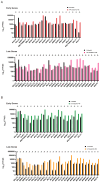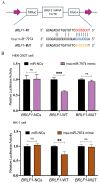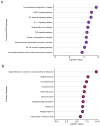Hsa-miR-7974 Suppresses Epstein-Barr Virus Reactivation by Directly Targeting BZLF1 and BRLF1
- PMID: 40431607
- PMCID: PMC12115523
- DOI: 10.3390/v17050594
Hsa-miR-7974 Suppresses Epstein-Barr Virus Reactivation by Directly Targeting BZLF1 and BRLF1
Abstract
Epstein-Barr virus (EBV) reactivation, a key factor in Epstein-Barr virus (EBV)-associated malignancies, is regulated by specific cellular microRNAs (miRNAs). This study investigated the role of Hsa-miR-7974 (miR-7974) in this process. miRNA sequencing revealed significant downregulation of miR-7974 in reactivated EBV-positive cell lines (Raji and C666-1). Bioinformatics prediction and dual-luciferase assays confirmed the direct targeting of the EBV immediate-early gene BRLF1 by miR-7974. Furthermore, miR-7974 mimics suppressed, whereas inhibitors increased, the expression of key EBV lytic genes (BZLF1, BRLF1, and BMRF1) and the viral load, as validated by RT-qPCR. Bioinformatics analyses revealed the involvement of miR-7974 in cellular pathways such as membrane dynamics and signal transduction (MAPK, NF-κB, and IL-10), and its association with Hodgkin's lymphoma, leukemia, and nasopharyngeal neoplasms. These findings establish that miR-7974 functions as a crucial negative regulator of EBV reactivation by directly targeting BRLF1, highlighting its potential significance in the pathogenesis of EBV-associated malignancies.
Keywords: Epstein-Barr virus; hsa-miR-7974; lytic cycle; reactivation.
Conflict of interest statement
The authors declare no conflicts of interest.
Figures










Similar articles
-
Profiling miRNA changes in Epstein-Barr virus lytic infection identifies a function for BZLF1 in upregulating miRNAs from the DLK1-DIO3 locus.PLoS Pathog. 2025 Jul 17;21(7):e1013347. doi: 10.1371/journal.ppat.1013347. eCollection 2025 Jul. PLoS Pathog. 2025. PMID: 40674434 Free PMC article.
-
MicroRNA miR-BART20-5p stabilizes Epstein-Barr virus latency by directly targeting BZLF1 and BRLF1.J Virol. 2014 Aug;88(16):9027-37. doi: 10.1128/JVI.00721-14. Epub 2014 Jun 4. J Virol. 2014. PMID: 24899173 Free PMC article.
-
IRF6 controls Epstein-Barr virus (EBV) lytic reactivation and differentiation in EBV-infected epithelial cells.PLoS Pathog. 2025 Jun 26;21(6):e1013236. doi: 10.1371/journal.ppat.1013236. eCollection 2025 Jun. PLoS Pathog. 2025. PMID: 40569988 Free PMC article.
-
Molecular Basis of Epstein-Barr Virus Latency Establishment and Lytic Reactivation.Viruses. 2021 Nov 23;13(12):2344. doi: 10.3390/v13122344. Viruses. 2021. PMID: 34960613 Free PMC article. Review.
-
Antibodies Against Epstein-Barr Virus as Disease Markers of Gastric Cancer: A Systematic Review.Technol Cancer Res Treat. 2023 Jan-Dec;22:15330338231169875. doi: 10.1177/15330338231169875. Technol Cancer Res Treat. 2023. PMID: 37078150 Free PMC article.
References
-
- Schober T., Framke T., Kreipe H., Schulz T.F., Grosshennig A., Hussein K., Baumann U., Pape L., Schubert S., Wingen A.M., et al. Characteristics of early and late PTLD development in pediatric solid organ transplant recipients. Transplantation. 2013;95:240–246. doi: 10.1097/TP.0b013e318277e344. - DOI - PubMed
MeSH terms
Substances
LinkOut - more resources
Full Text Sources

